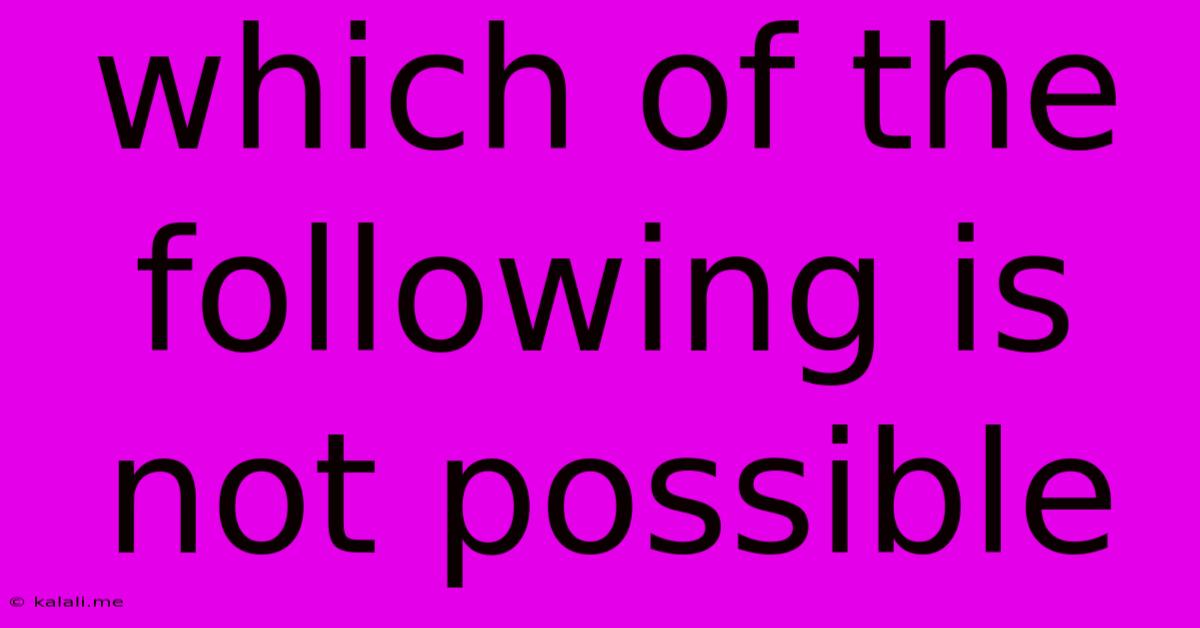Which Of The Following Is Not Possible
Kalali
Jun 16, 2025 · 3 min read

Table of Contents
Which of the Following is Not Possible? Exploring the Limits of Possibility
This seemingly simple question, "Which of the following is not possible?", opens a fascinating exploration into the boundaries of our understanding of physics, logic, and the universe itself. The answer, of course, depends entirely on the "following" presented. This article will delve into the criteria for determining possibility, examining examples from various fields and highlighting the nuanced nature of this seemingly straightforward query. Understanding what's not possible helps us better grasp what is possible, pushing the boundaries of innovation and understanding.
Defining Possibility: A Multifaceted Concept
Before we dive into specific examples, it's crucial to define what we mean by "possible." Possibility isn't solely a scientific concept; it's intertwined with philosophy, ethics, and even theology. We can approach possibility from several perspectives:
-
Physically Possible: This refers to events that don't violate the laws of physics as we currently understand them. For example, building a perpetual motion machine is not physically possible due to the laws of thermodynamics.
-
Logically Possible: This refers to events that don't violate the laws of logic or entail contradictions. For instance, a square circle is not logically possible.
-
Technologically Possible: This refers to events that are currently feasible given our existing technological capabilities. While space travel to Mars is physically possible, achieving it within a specific timeframe might not be technologically possible with our current resources and technology.
-
Practically Possible: This considers the feasibility of an event given constraints like time, resources, and ethical considerations. Building a massive pyramid in a desert might be physically and technologically possible, but practically impossible given the costs and logistical challenges.
Examples of the "Impossible"
Let's explore some examples illustrating the different aspects of possibility:
1. Faster-than-light Travel: Currently, according to Einstein's theory of special relativity, faster-than-light (FTL) travel is considered not physically possible. This is because it would require infinite energy and violate causality. However, the possibility of wormholes or warp drives remains a topic of theoretical physics, albeit highly speculative.
2. Time Travel to the Past: While time travel to the future is theoretically possible (through relativistic effects), traveling to the past presents significant paradoxes, such as the grandfather paradox. Therefore, backwards time travel is often considered not logically possible within our current understanding of physics.
3. Creating a Perfect Vacuum: A perfect vacuum, devoid of all matter and energy, is not practically possible. While we can create extremely high vacuums in laboratories, eliminating every single particle is beyond our current technological capabilities.
4. Predicting the Future with Certainty: Predicting the future with absolute certainty is not possible due to the inherent chaotic nature of many systems and the limitations of our predictive models. While we can make probabilistic predictions, complete certainty remains elusive.
The Ever-Shifting Landscape of Possibility
It's essential to remember that our understanding of what's possible constantly evolves. Advances in science and technology frequently challenge previously held beliefs about the impossible. What seems impossible today may become commonplace tomorrow. This continuous evolution highlights the importance of critical thinking, scientific inquiry, and a willingness to explore the seemingly impossible.
Conclusion: Embracing the Unknown
The question, "Which of the following is not possible?" underscores the multifaceted nature of possibility itself. By carefully considering the physical, logical, technological, and practical limitations, we can better understand the boundaries of our current knowledge and strive to push them further. The exploration of what's not possible is often just as valuable, if not more so, than the pursuit of what is. It fuels innovation, challenges assumptions, and ultimately expands our understanding of the universe and our place within it.
Latest Posts
Latest Posts
-
Reactive Power Formula In 3 Phase
Jun 16, 2025
-
Least Common Multiple Of 40 And 50
Jun 16, 2025
-
Nitrogen Used By Plants Is In The Form Of
Jun 16, 2025
-
Can You Take The Act As An Adult
Jun 16, 2025
-
What Is Unit Weight Of Water
Jun 16, 2025
Related Post
Thank you for visiting our website which covers about Which Of The Following Is Not Possible . We hope the information provided has been useful to you. Feel free to contact us if you have any questions or need further assistance. See you next time and don't miss to bookmark.